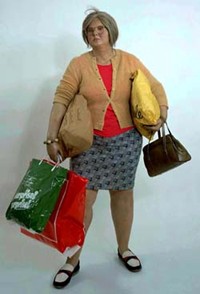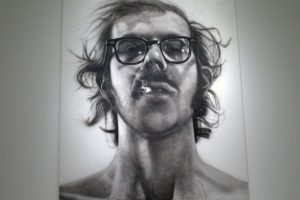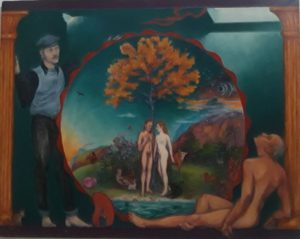OK, let’s cut to the chase. “Sanitation.” Is it any good?
I mean, in the artistic sense.
It is, after all, supposed to be a work of art, not just a political volley in the culture wars.
You’re supposed to get in that darkened room with all those saluting plastic trash barrels and feel something.
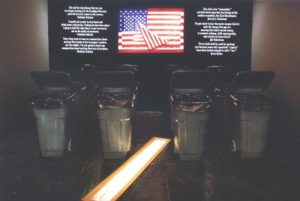
You’re supposed to feel your freedom threatened. You’re supposed to feel that there are repressive forces goose-stepping in your direction. “First they came for the artists…”
Why else invoke the Nazis? All political art is propaganda. Whatever the cause, good or bad, it tries to sway your thinking by sneaking in the back door, by appealing to your emotions. If it’s powerful propaganda, you can feel the pull, even if it doesn’t take you in.
Hans Haacke’s “Sanitation,” part of the Whitney Biennial and the subject of numerous stories because of its attack on Mayor Rudolph Giuliani, is weak propaganda. It lacks the insidious cleverness of the strong stuff. Those plastic trash barrels, for one thing, do nothing for me. They’re all lined up, with their neat plastic liners, and their lids popped up. I know you’re supposed to think soldiers, uniforms, “Heil Hitler,” but I just can’t make the leap.
The marching doesn’t help, nor does the Fraktur script. It’s too overblown, too heavy-handed, too redolent of Sixties hyperbole.
Let’s face it. All politics aside, even on its own terms, it’s a mediocre work. It was designed for a single purpose, to provoke the mayor through the press, to goad him into charging at the museum with his horns down. People like that kind of thing. And it makes money for museums.
But it ain’t art.
The irony is that this will always be remembered as the Hans Haacke Biennial, even though the curators make a big point of saying that political art has run out of gas, that there’s been a “dulling of the sharper edges of social commentary,” to quote museum director Maxwell Anderson.
Haacke was the token political artist.
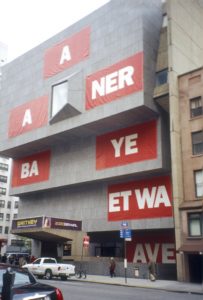
What the show is about, no one can quite say. In past years, the buzzwords have been “cutting edge,” or “subversive,” or “race-sex-gender.” One year it was “the return to painting.”
This year, no buzzword. There’s a little of this, a little of that. Perhaps that’s because this show has six curators from different corners of the country. You have to hand it to the Whitney. They’ve tried every kind of curatorial arrangement: inside curators, outside curators, single curators, teams of curators. Now geographically dispersed curators. Nothing seems to work, apparently, because they never repeat the same one.
A problem with many of the works in this show is that they seem only to exist for the purpose of the Whitney Biennial. You can’t imagine them having a life outside of this rarefied atmosphere.
This holds true for most of the installation art, which has become a big favorite at the Whitney, apparently because of the entertainment value.
This year, installation artist Tara Donovan covered an entire floor with thousands of very, very thin filaments of electrical wire. The hair-like pieces of wire have been very carefully placed, one next to another, so as to create a billowy landscape of concentric ripples. Much is made, in the wall text, of the time and obsessive effort it must have taken to shred all this electrical wire, and to carefully arrange it in this particular pattern. Nothing, however, is said about why.
In a lighter vein, Annette Lemieux creates a playground of sorts and populates it with truncated feet. The cast-wax feet teeter on a seesaw, kick a ball, walk on a rope. One poor pair stands in the corner, a dunce cap on its ankles.
Americans love cars, and American artists are no exception. One year the Whitney had a hearse that was covered – every square inch – with lube grease. This year there’s a cute MG Midget, which the artist, Kim Dingle, has dressed up like a doll, with a pink paint job and frilly lace hubcap covers. The artist calls it a “Priss Mobile” and “a big baby car on a big soft blanket.” And though it doesn’t say so, you can be sure that, in the popular parlance, it has something to do with “gender and identity.”
There’s nothing prissy about Chakaia Booker’s wall-sized assemblage of sliced and twisted rubber tires. It is actually one of the show’s most visually arresting pieces. The rubber has a life, and each individual piece wants to spring out of the knotted, compressed form that it’s somehow been jammed into, and get back to its original form. Hence, the whole has a kind of seething, writhing energy, like the suffering souls in Rodin’s “Gates of Hell.”
Also in the category of artists who do things with unusual materials is Vik Muniz, who used “Bosco syrup” to make an image of the 19th century masterpiece, “Raft of the Medusa,” by Theodore Gericault. His explanation for why he does this involves parallels between the collapsed forms of the dying people on the raft, and the tendency of the Bosco to run and drip during execution, and the urgency to photograph it before it dries.
Yukinori Yanagi has an even stranger gimmick. He fills plastic plexiglass boxes with sand, packs it so hard that he can imprint an image on its surface – in this case, dollar bills – stands them on edge, and then – what else? – lets ants loose inside. Presto! An ant farm.
In contrast to Haacke’s artificial alarmism, there are some genuinely scary moments in this show, as in the film “Fervor,” by Iranian born artist Shirin Neshat. She provides a glimpse into the collective zeal and hypnotic power of Islamic fundamentalism. And Doug Aitken, who makes music videos, taps into urban paranoia with “Electric Earth,” a nighttime journey through deserted parking garages and empty streets, with eerie closeups of oddly animated things – a kicked bottle cap, a spinning shopping cart, and a dollar bill left on its own, jerking back and forth in a vending machine slot.
This biennial has its moments, as do most shows. Its biggest deficiency is the failure to produce any coherent whole, or even a big chunk of something. Occasionally, themes seem to coalesce – a couple of artists use grotesque distortions of the female form, for example – but it’s usually just a tease. It doesn’t go anywhere. There’s little sense of one thing connecting to another within a show, or any sense, for quite a while now, of one biennial connecting to another and adding up to anything like a style or movement.
Instead the artists scatter, as if on a children’s treasure hunt, and come back with random and whimsical things. Two years later they do it again with the same results. I suppose that’s what happens when all you worship is novelty.
Whitney Museum of American Art
2000

